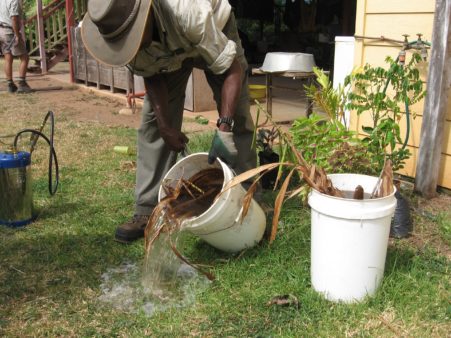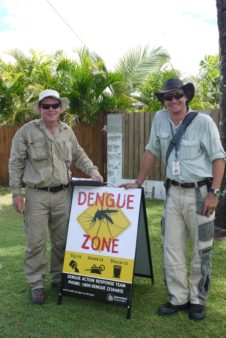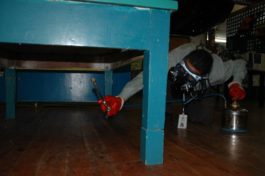- by Alison
Dengue in Cairns: reducing local transmission despite imported cases

Lying in the northernmost region of Queensland in North East Australia, the city of Cairns is no stranger to dengue. This gateway to the Great Barrier Reef has seen almost 40 outbreaks and more than two thousand cases since 2000, including more than 900 cases during a dengue epidemic in 2008. While imported cases have been on the rise during the past decade, local transmission of dengue in Cairns has been on the decline. We explore why.
A growing year-round challenge
“Our dengue season here in Cairns coincides with our wet summer season and typically runs from December to May,” says Mr. Joe Davis, Director of Medical Entomology at Cairns Public Health Services and Manager of the Cairns Dengue Action Response Team (DART). “Even during the winter, it’s still warm enough for mosquitoes to mature – but the lifecycle is slower, which means there are fewer mosquitoes around and so less transmission.”

Throughout the year, travelers import dengue into Cairns from dengue-endemic countries across South East Asia through being infected themselves. And with growth and development in nearby South East Asian countries, fly in-fly out workers based in Australia are also at risk of importing the virus.
With that in mind, it’s hardly surprising that imported cases of dengue in Cairns have been rising over the past couple of decades. “In the early 2000s there would have been five to ten imported cases each year,” says Mr. Davis. “In 2015, that number rose to more than 80.”
DART: flying into action
Despite an increase in dengue cases imported into Cairns, local transmission has decreased thanks to effective treatments and methodologies. Whenever a potential case arises, Mr. Davis’ DART team is quickly called into action, quashing any outbreak.
Is low-cost travel spurring dengue outbreaks?
Dengue is a notifiable disease in Queensland. Any doctor suspecting dengue must notify the Cairns public health unit, which notifies the DART team. The team’s rapid response starts at the patient’s residence. “We target our application of pesticides where the Aedes aegypti mosquito likes to rest – under sofas and tables, in dark hiding places and amongst laundry,” says Mr. Davis. “We also treat any containers in the back yard and within a sufficient buffer zone around the property.”

The team also treats any places the patient has visited since their symptoms first appeared in the same way. These additional properties can significantly increase the number of response areas.
Expanding as needed
If the dengue case is locally-acquired, the team increases that buffer zone significantly – to as much as an entire suburb. Mr. Davis explains why: “With locally-acquired dengue, we know there is local dengue transmission in that area. That means the imported dengue has infected local mosquitoes and we are likely to have more cases.”
If the number of dengue cases does start to rise, the DART team can expand quickly – from a core team of ten up to the required number of vector control officers, depending on the size of the outbreak.
The team also expands at the start of each wet season. Additional staff is brought in to help with preventative measures.
Dengue in Cairns a proactive approach to control
Indeed, the team doesn’t rest during the winter or during periods when there is no transmission; it continues its focus on prevention, which includes visiting properties known to be at high risk for the Aedes aegypti mosquito. “We visit people who routinely keep a lot of stuff in their yard, along with car wreckers’ and tire yards, to make sure there are no mosquitoes there,” says Mr. Davis.
Mr. Davis and his team also take a proactive approach to suppressing Aedes aegypti mosquito populations; they visit places at risk for imported cases, such as backpackers’ accommodation. Here they put up posters, treat common areas with pesticides, and check and treat any empty containers that are lying around.
 During the wet season, the team visits monthly; during the dry season, they visit once or twice throughout the season.
During the wet season, the team visits monthly; during the dry season, they visit once or twice throughout the season.
Wolbachia mosquitoes
Cairns has had a new tool help it in its fight against dengue: the Wolbachia mosquito we wrote about earlier this year in ‘Learn how Wolbachia bacteria are reducing the impact of dengue’. Wolbachia mosquitoes are mosquitoes infected with Wolbachia bacteria, which reduce the dengue virus’ ability to replicate and the mosquitoes’ ability to transmit dengue.
“We have had no dengue outbreaks in any suburb with Wolbachia mosquitoes,” says Mr. Davis, “And that’s in spite of local transmission in other suburbs in our region.”
The Eliminate Dengue Program began releasing Wolbachia bacteria-infected mosquitoes in Cairns in 2011, initially in two suburbs – including Parramatta Park. Historically, Parramatta Park was a hot spot for dengue outbreaks because of the age and style of its housing and the leafy vegetation that grows there. But the Parramatta Park area where Eliminate Dengue released Wolbachia mosquitoes has not seen any dengue outbreaks since 2011.
In 2012, Eliminate Dengue expanded the initial two suburbs to four, then added further suburbs into the release program in the following years. By last season, the program had covered all Cairns suburbs with historical local dengue transmission. “Every time Eliminate Dengue releases Wolbachia mosquitoes into an area, local dengue outbreaks cease in that area,” says Mr. Davis.
By the time the 2017/2018 dengue season begins, Eliminate Dengue will have completed its Wolbachia mosquito releases in all of Cairns’ suburbs. It could be a monumental year for the city, as Mr. Davis says: “It will be interesting to see if we have any dengue outbreaks at all this coming summer.”
Even with the Wolbachia mosquitoes on its side, Mr. Davis knows his team cannot be complacent. It must continue to respond to imported dengue cases and proactively prevent dengue outbreaks. “I will be interested to see how the Wolbachia approach will complement our services and how it will shift our focus,” Mr. Davis concludes.
Share your news on how your community is taking the fight to dengue. What initiatives do you have in place and what impact are they having?
—
Now you can create a record of dengue near you in just a few clicks. Report dengue infections using Dengue Track!

